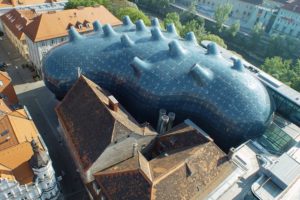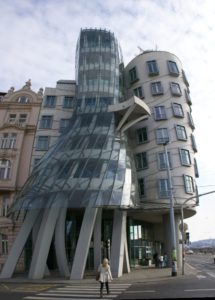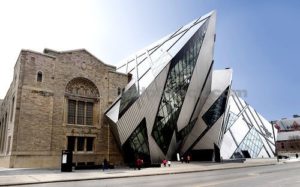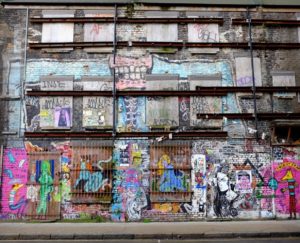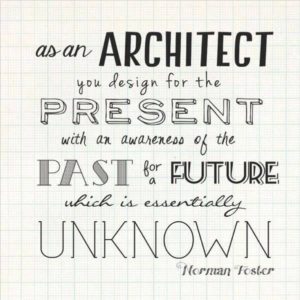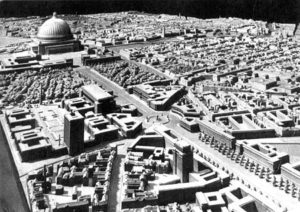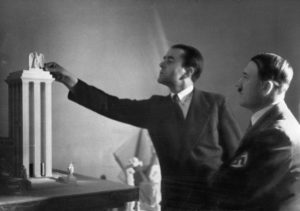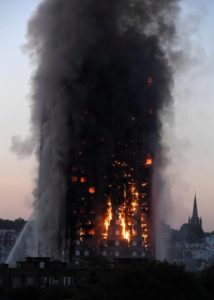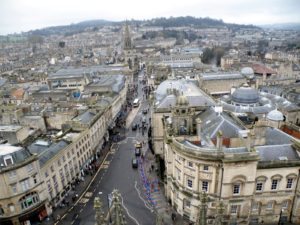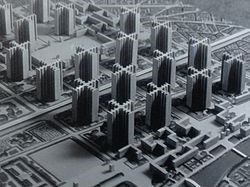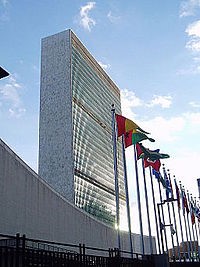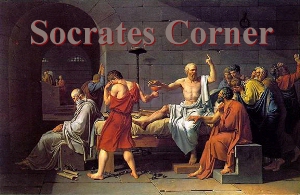Architecture designed to kill the Human Spirit, Part 1
Modern Building of Kunsthaus Museum of Contemporary Art by Architects Peter Cook and Colin Fournier in Graz Styria Austria
| About the Author—Professor Ellis Washington, J.D.—I went to Harvard Law School with future POTUS Barack Hussein Obama for 1 year (1988-89), but I took the opposite path in Life—New World Order, Communism, Treason, Pedophilia & Satanic Ritual Abuse vs. Christianity, Conservatism, Protecting the Children & TRUMPism. I repeatedly refused to take the “Satan OATH” which is why I’ve been blacklisted for 30+ years—for my entire legal and academic career, yet I Fight on! Why?—For Harvard’s original 1692 motto—Veritas pro Christo et Ecclesia {= Truth for Christ and the Church}.
To escape the 150-Year Rothschild Chattel Slavery systems (e.g., Birth certificates, Social Security numbers bought, sold & traded on Wall Street) & Rothschild Debt Slavery systems (e.g., IRS, Income Taxes, fiat/counterfeit currency based on NOTHING, printed to fund false flag wars) of the Rothschild Khazarian Mafia Matrix (1871-2021), read and share the Truth of my Critical Thinking blog with the Youth that’s nearing 20 Million views @ EllisWashingtonReport.com & on Facebook — #JesusIsLord #DCActof1871 |
Why is modernist and postmodernist architecture so grotesque? Because right after World War II radical architects launched a revolution against earlier traditionalist styles believing they represented colonialism, racism, slavery and exploitation. It was the revenge of mediocrity upon talent and taste… They were the Social Justice warriors of their time—Aesthetic terrorists.
~ Paul Joseph Watson
Do not set out to destroy society – you’ll frighten men. Flood society with mediocrity men in high places – and society is destroyed.
~ Ellis Washington (a paraphrase of Ayn Rand)
Prologue to Dystopia and Deconstruction
Social Media savant, InfoWars host and iconoclastic writer from England, Paul Joseph Watson, in a June 30, 2017 program titled, Why Modern Architecture Sucks, delivers a tour de force on the little-understood but ancient Philosophy of Aesthetics. Specifically, Watson gives a wonderful and revelatory critique on the deconstruction of modern art and architecture ubiquitously called “Modernism” and “Post-modernism”. Yet, it is more than that modern architecture has evolved to become voluntary concentration camps that people are enslaved in their daily lives, yet are too obtuse or delusional to realize that today’s self-appointed “architects” have purposely created an ugly architecture specifically designed not as an architecture that uplifts and enlightens, but an architecture of tombs and coffins, dystopia, deconstruction and death made of concrete and steel, iron, glass and created for the sole purpose of killing the human spirit.
In a 2010 Socratic dialectical essay, Symposium—Music, Art and the Wagnerian Dilemma, I addressed the question of intrinsic beauty in art, but this idea can easily apply to the Aesthetics of architecture also. Here is an excerpt from that opus:
Socrates: We are gathered here today at my Symposium to discuss the venerated discipline of aesthetics and to seek to answer this question of the ages – Can immoral art [or ugly architecture] be good? Or more pointedly, can an immoral person create good art [or architecture]?
Wimsatt & Beardsley: Yes, Socrates, philosophers call this paradox the intentional fallacy, which developed in the New Criticism School of the 1930s and was first used by us in a 1946 essay. A long-running debate in philosophy has centered around the question of whether art that is morally bad can itself be good (as art).
New Critics believe that an interpretation of a work should focus purely on its objective qualities; we should strictly disregard all external or extrinsic factors (biographical, historical, etc.) concerning the author of the work.
Leni Riefenstahl: The question of the intentional fallacy has tended to focus on controversial figures like Caravaggio, Van Gogh, Gauguin, Picasso, Andreas Serrano (“Pi– Christ” [1989]) or artists such as myself, for I was the German filmmaker for the Third Reich, the Nazi Party and for supreme chancellor of Germany, Adolf Hitler, whom I immortalized in such documentaries as “Triumph of the Will,” which chronicled the Nuremberg rallies, and “Olympia,” a documentary on the 1936 Berlin Olympics. I am profoundly ashamed of these movies now in light of Nazi atrocities and the human-rights genocide of the Holocaust, for my so-called art was exploited as Nazi propaganda. Nevertheless, many critics to this day consider my movies to be technically and artistically brilliant…
Wimsatt & Beardsley: As progressives, we view art as public works. The poem is not the critic’s own and not the author’s. It is detached from the author at birth and goes about the world beyond his power to control it. The poem belongs to the public…
Socrates: Much of modern art since 1900 isn’t about beauty, but has devolved into an unedifying mix of snobbishness, greed, grotesqueness and fetishism, which the intentional fallacy has only made worse. How? Because the New School Critics have legitimized the separation of God from art, goodness from beauty, art from truth, thus much of modern art has become an exaltation of evil, caricature, deception, politics and pride – rather than truth, virtue, beauty, realism and godliness.
Why Modern Architecture Sucks?
PAUL JOSEPH WATSON: Why should we care about the architecture that surrounds us? This isn’t about feeling aesthetically pleased by what we see. Buildings broadcast a message, good and bad architecture can lift or subdue the human [spirit]. The architecture we leave behind also represents the legacy of our contribution to human history. The buildings we build directly impacts our quality of life and the nature of the environment that surrounds us, and that’s why it matters because aesthetic ugliness encourages ugly behavior; municipal pride evaporates.
JAMES KUNSTLER (Writer, Social Critic): Your ability to create places that are meaningful and places of quality and character depends entirely on your ability to define space with buildings to inform us who we are. And when you degrade the public, the public realm you will automatically degrade the quality of your civil life.
PAUL JOSEPH WATSON: Yeah, but there is no good or bad architecture; just like there’s no good or bad art. It’s all subjective—B.S.! We were spoiled by thousands of brilliant architectures—all of it different in styles, but impeccable in taste. Now we’re increasingly surrounded by atrocities like this.
The Nationale-Nederlanden Building (left), designed by Frank Gehry. Example of Anthropomorphism – the idea of giving human characteristics to non-human things.
Why is Modernist and Postmodernist architecture so grotesque? Because right after World War II radical architects launched a revolution against earlier traditionalist styles believing they represented colonialism, racism, slavery and exploitation. It was the revenge of mediocrity upon talent and taste. They were the Social Justice warriors of their time—Aesthetic terrorists; the architectural equivalent of abstract modern artists. And just like virtually all abstract modern artists, everything they produced was relentlessly hideous. Post-war architects were also egomaniacs who were so strident about standing out from the beauty that proceeded them, they rebelled by producing unremitting ugliness.
ARCHITECTURE DOCUMENTARY: The American architect, Louis Sullivan expressed the credo of the Modernists when he said that “Form follows Function”, in other words stop thinking about the way a building looks and think instead about what it does. Sullivan’s doctrine has been used to justify the greatest crime against beauty that the world has yet seen and that is the crime of modern architecture. And the result proves as clearly as can be that if you consider only utility the things you build will soon be useless.
JOHN STUART MILL: In a 2015 Socratic dialectical essay titled, Symposium—Federalists, Anti-federalists and Utilitarianism, I stated Mill’s Utilitarian philosophy which believes in this credo called the Happiness Principle – a good law, the right act or policy [art or architecture] is that which provides the greatest happiness to the greatest number of people. An individual who follows this worldview will think of the consequences of their acts and will make their choice or action on the one that reduces consequences, making a decision about what will bring about the greatest happiness to the most people.
Abandoned buildings – Scalter St., London, England
ARCHITECTURE DOCUMENTARY: This building is boarded up because nobody has a use for it. Nobody has a use for it because nobody wants to be in it. Nobody wants to be in it because the thing is so damn ugly… Everything has been vandalized, but we shouldn’t blame the vandals. This place was built by vandals and those who added the graffiti merely finished the job.
When Nazi Architecture became ‘the Establishment’
PAUL JOSEPH WATSON: But just like the art world, this rejection of the establishment has become the establishment. Prince Charles was right…
PRINCE CHARLES: What I do not think is sensible in the long-run when the avant-garde becomes the establishment. And that is what has happened I believe, not only in architectural terms, but in many other areas as well…
PAUL JOSEPH WATSON: Not only is Modernist architecture manifestly horrid, its inherently totalitarian. Modernist guru, Le Corbusier deliberately lobbied for the construction of giant, brutalist residential [Concentration Camps] on the fringes of cities to atomize and segregate the workers in the lower classes from the technocratic elite. “We must create a mass-production state of mind,” he raved, demanding every city in the world adopt the same uniform style of bleak, concrete totalitarianism.
Germania: Hitler’s Dream Capital designed by Nazi Architect, Albert Speer.
{Wikipedia} “Charles-Édouard Jeanneret, known as Le Corbusier (October 6, 1887 – August 27, 1965), was a Swiss-French architect, designer, painter, urban planner, writer, and one of the pioneers of what is now called modern architecture. He was born in Switzerland and became a French citizen in 1930.”
DOCUMENTARY: [The Nazi-inspired architecture strived] to produce a new society which would in a sense be social engineering through architecture.
PAUL JOSEPH WATSON: Cities like London and Birmingham have been irreparably damaged by Le Corbusier inspired brutalist towers blocks that attract nothing but crime and degradation — Ceausescu style mass housing that served to desecrate both the landscape and people’s aspirations.
DOCUMENTARY: What succeeded after the war has succeeded in wrecking London’s skyline and obliterating the views of St. Paul’s [Cathedral] and in a jostling scram of skyscrapers—all competing for attention. And look at how the Birmingham City Center became a monstrous concrete maze that only cars could find their way through-people didn’t stand a chance. Cars were placed above people, and people were placed one above the other on concrete shows.
PAUL JOSEPH WATSON: Modernist architecture had so little foresight that after a time these tower blocks streaked with water stains and infected with [mold], mimicked and provoked the moral decay of their surroundings. Now the plastic cladding intended to provide a half-hearted facelift has only succeeded in turning them into death traps.
Tower block, coffin architecture built for destruction—Grenfell Tower, (1972-74) (West London, England). Destroyed by fire, 14 June 2017.
UK NEWS REPORT: The problem with Grenfell Tower was a very deep-seated one. It goes back to the point at which it was thoroughly popular to put up tower blocks as an exercise in social engineering. There are opinion surveys going back to the 1940s and when people are asked what type of property do they want to live in, 80% say a house, 2 or 3% say tower blocks. What can the Speaker and the politicians and the bureaucrats give to the people so that there are 4,000 of them [tower block “Projects” which I prefer to call “Concentration Camps”] now blighting our landscape? We gave them tower blocks which they did not want. We must recognize that people want houses not tower blocks. And we must build them houses and get rid of tower blocks and then allow them, as Margaret Thatcher did, to become humans.
Le Corbusier: The Nazi Collaborator whose Architecture Killed Aesthetics
PAUL JOSEPH WATSON: In the 1950s local authorities even wanted to demolish the Georgian city of Bath—the most architectural beautiful city in the whole of England, and bury it under.
Iconic Georgian city of Bath, England
As Theodore Dalrymple notes, “These British are barbarians camped out in the relics of an older and superior civilization to whose beauties they are oblivious.” The despairing malaise that seems to hang heavy in the UK air permeates from these concrete monuments to misery up-and-down the country. And if anyone’s to be blamed its Nazi collaborator Le Corbusier…
DOCUMENTARY: Said to be the most influential, the most admired and the most detested architect of the twentieth century.
Le Corbusier: The [‘Lego’] model of the Plan Voisin for the reconstruction of Paris displayed at the Pavilion of the Esprit Nouveau (1922-39)
The Headquarters of the United Nations designed by Le Corbusier, Oscar Niemeyer and Wallace K. Harrison (1947–52)
PAUL JOSEPH WATSON: He [Le Corbusier] schemed to destroy entire cities to realize his fevered dream of autocratic urban planning and he was partly successful—everywhere you go in London these hulking monoliths imposed their repulsiveness ruining the harmony of entire townscapes, ghettoizing the environment, forcing people to live in concrete ant heaps.
STONE WASHINGTON: It was the summer of 2015, that was the first time I ventured into the United Nations building in New York. I was an ENVISION scholar at the Global Young Leader’s Conference, following my graduation from Grosse Pointe South High school. I was one of roughly 400 invited students, from various foreign countries all over the World including: China, Trinidad, France, England, Israel, Yemen and many other countries. While I was infatuated to explore the iconic streets of downtown New York where the conference was held, and to witness all of the amazing sites and traditionalist architecture of America’s premier city, nevertheless my feelings of grandeur and exaltation soon took a turn for the worse when we arrived for the final segment of our conference, and entered the UN building as part of our United Nations Security Council simulation exercise in geopolitics.
During my entire time visiting what I now understand to be the United Nations building designed by Nazi-inspired architect Le Corbusier, I distinctly remembered feeling a sense of foreboding, dread, and despair as I witnessed the blank concrete columns and rigged rectangular design of the building void of any ornamentation (very similar to the design of a prison). As described in the architectural debate above, it was as if we were being imprisoned inside a concrete tomb, surrounded by amorphous design and tasteless abstract art.
Upon completion of the UN simulation, I would find that the design of this building appropriately represented the meaningless and fruitless methods of the United Nations original mandate—to make “war an illegal thing” as FDR’s Secretary of War Henry L. Stimson naively said. Likewise the architecture of the UN was not representative of the iconic Art Deco, Art Nouveau, Gothic, Neoclassical, Baroque, Greco-Roman, and other traditionalist architectural forms that defines New York, making this city one of the most architecturally magnificent cities in the world.
Le Corbusier’s Concentration Camp on the Hudson called the United Nations building had now blighted a once iconic city skyline in New York.
DOCUMENTARY: Queen Square in Old Trafford; this is where I grew up and it was demolished in the late 1960s and in a way, it was like having one’s childhood wiped away. In Queen Square, my grandmother occupied the fourth house, we occupied the fifth house, and the sixth house was occupied by my mother’s sister and her family, so it was a very strong community; very tight, very solid and it was also quite happy.
Well there’s nothing at Queen Square now. As you can see everything has just vanished; it’s just like the whole thing has been completely erased from the face of the earth. I feel great anger, I feel massive sadness. It’s like a complete loss of childhood. Now, when I pass through here or even being here today it’s so foreign to me and that’s quite sad I think.
PAUL JOSEPH WATSON: Thanks to stupid and corrupt counselors, this nihilistic loss to bury Britain’s architectural heritage [Bath, Birmingham, London, England] under a mass of modern detritus hasn’t abated since. They’ve just swapped the piles of reinforced concrete for mountains of soulless, inhumane glass and steel.
DOCUMENTARY: When the public began to react against the brutal concrete style of the 1960s, architects simply replaced it with a new kind of junk, glass walls hung on steel frames with absurd details that don’t match. The result is another kind of failure to fit and is there simply to be demolished.
Epilogue Against Nietzsche’s Nihilism in Architecture
Watson’s use of the word “nihilism” to describe much of the Modern and Postmodern architecture reminds me of great German philosopher and the father of nihilism philosophy, Friedrich Nietzsche (1844-1900), who ironically died at the advent of the Modern Age. An atheist, Nietzsche hated Christianity and in many his philosophical works like—Genealogy of Morals, The Gay Science, Thus Spoke Zarathustra, and Beyond Good and Evil, among other works, invidiously slandered Christianity and Christians as apostles of a “slave morality.” The Judeo-Christian traditions and institutions that gave the World the Protestant Reformation, the Age of Enlightenment, the American Revolution—Judeo-Christian traditions and institutions that redeemed the world out of the Dark Ages, out of global paganism and superstition into the Renaissance, and with artists and architects like the founding father of the Renaissance, Filippo Brunelleschi (1377-1446), Da Vinci, Michelangelo, Raphael, Donatello, Botticelli, Caravaggio, Rembrandt, Titan, Jan van Eyek, El Greco, and many other geniuses of Art, Architecture, and design. Here, aesthetic beauty and objective realism reached new and ever rising heights until it was destroyed at the advent of Modernism and Postmodernism architecture beginning about 1900.
Architecture was adversely affected by the Nietzsche paradigm shift from Christian Theism to Darwin’s Evolution Atheism and “Survival of the fittest” Nihilism, thus by the 1930s led by “Urban Planners”, like Le Corbusier, who systematically applied Nazi and Holocaust Brutalism in architecture; it’s effect in the words of Paul Joseph Watson manifested “hulking monoliths that imposed their repulsiveness, ruining the harmony of entire townscapes, ghettoizing the environment, forcing people to live in concrete ant heaps.” These “concrete ant heaps” we understand in hindsight to be tower block coffins that combined in the millions in cities across the World to create “Projects”, or what the Nazis called “Ghettos” and “Concentration Camps”—planned designs of social engineering architecture built by their fascist creators to house useful slaves inside their tombs and coffin apartments.
This is the ignominious legacy Modernism and Postmodernism architecture—Voluntary Concentration Camps for the masses.
*See essay, Architecture Designed to Kill the Human Spirit, Part II.
Category: Commentary


